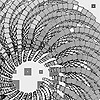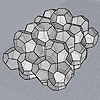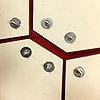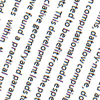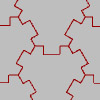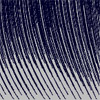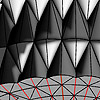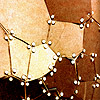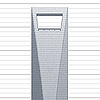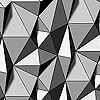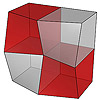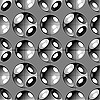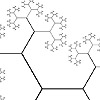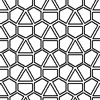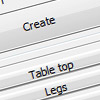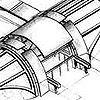A newly established student club, “E3 Architecture and Design” is organizing a two-day workshop at İstanbul Bilgi University Faculty of Architecture between June 10-11, 2013. The Grasshopper Workshop will be the first one in the faculty. The event will be conducted at our computer lab. so the seats are limited to 28. I’ll try to explain the basic concepts of dataflow management in computer-aided design. Also, I plan to test […]
Becoming popular after the Beijing 2008 Olympics National Aquatics Centre‘s facade (which is believed to be a Voronoi subdivision, as an epic mistake), the Weaire Phelan structure is a solution of equal volumes with minimal surface area. Although it is a structural solution, I think for architects, catching the eye with “cute bubbles” seems to be the primary purpose of this structure. (images from arup.com) A More Formal Explanation This […]
Below is the final production of the three-day workshop at Bolu İzzet Baysal University Faculty of Engineering and Architecture. For more information about the process and the photos from the first student prototypes, you may visit the workshop blog at infections2.blogspot.com Grasshopper definition developed within the workshop is a simple multi-attractor system that deforms (or re-constructs) a regular square grid using the well-known Voronoi subdivision. I’ll post the definition here.
This is an old research paper, prepared with Birgül Çolakoğlu. It is in Turkish and includes our first results in some of the Rhinoscript exercises. Here is the abstract of the paper; Recent research in architecture have focused on to understand computational methods of formal exploration and expression. Computational mechanisms have been used to readdress formal issues using new techniques and methods. Computational tools that operate on algorithmic logic are central in […]
The Parquet Deformation exercise is generally originated with William Huff. Huff conducted it at several schools of architecture since the 1960s. Huff defines the exercise as rooted in two analytical disciplines; monohedral tilings in geometry, and the continuous deformations in biological morphology. This is generally exemplified by D’Arcy Thompson’s and Albrecht Dürer’s studies. One of the student’s works of Huff, Trifoliolate is a single-axis, single-prototile hexagonal parquet deformation. It was […]
I’ve seen beautiful examples of similar compositions made using vector field components in Grasshopper. I just tried to make my own animate field lines to see how they float over force dynamics. In essence, these compositions could also be done using regular vector components but the field components make life much easier by merging different forces together rather quickly. Here is my Grasshopper definition (be careful it may slow the […]
In Design Computing class, we have discussed how the parametric wall study (here) can be implemented to describe regular curved surfaces such as domes. This led us to well-known design compositions named Muqarnas. Previously we have studied how a parametric muqarnas definition could be in Grasshopper (here). After a couple of weeks of study, students started to capture the idea of generating seamless surfaces out of a few components. Of […]
The “Re_Flex Patterning” workshop will be conducted at İzzet Baysal University Faculty of Engineering and Architecture between 6-8th May 2013. The workshop is led by Tuğrul Yazar and Fulya Akipek, from the İstanbul Bilgi University Faculty of Architecture. Integrating digital media with the material world reveals emergent performances. Parametric modeling techniques encourage designers to study more on the envelopes of potentials instead of singular artifacts. Working with these envelopes tells […]
WFC Shangai is a design exercise in our first-year Design Computing class introduced by Onur Yüce Gün. This exercise emphasizes both analytical thinking and associative geometry and aims to utilize boolean operations as solid and void references in creating forms. We asked students to develop variations of this building. In order to discuss this formation in class, I studied a simple algorithm to test variations in real-time. The grasshopper definition […]
Here are some student works about the parametric wall exercise I briefly explained here along with a Grasshopper implementation of the core wall definition. Students are expected to design their own brick and compose it in a way that generates a seamless wall surface. Ömer Kirazoğlu Osman Can Sözüneri Seda Öznal (slightly out of requirement but very interesting) Adnan Faysal Altunbozar Özgüç Bertuğ Çapunaman
This is a first-year design computing problem we studied last month. It is a simple parametric wall exercise introduced by Mete Tüneri. Creating a simple definition of a building brick to be placed on a straight path, and then manipulating the path to reform different variations of the brick. This aims to introduce a fundamental concept of associativity in contemporary architectural geometry and design computing. Students are then encouraged to […]
This is a solid-void (or boolean) exercise for first-year students. It is initially introduced by Onur Yüce Gün as an in-class exercise but later became a design problem also. Before getting into the parametric wall and eventually muqarnas exercises, this small but effective assignment helps students understand some of the fundamental concepts such as associativity, solid/void relationships, and component-based design compositions in three dimensions. Here is the initial object we […]
Today’s design computing class was about fractals. In Rhino, writing macro statements are very easy to learn as it just mimics your behaviors in a sequential text. There are a few syntactic rules that we should know. First, you should watch the command line carefully to understand the steps of your design process. Each command in Rhino requires different inputs from the user. In macro, you may enter these values […]
One of the cult texts in Shape Grammars theory is Stiny‘s Chinese Ice-ray Lattices Grammars. Although it is full of technical terms, it represents an analysis of a working algorithm. We can directly transfer that from the behavior of an artist. “One can imagine a Chinese artisan, summoned to a building site. He brings tools and implements and a collection of finely finished sticks. Then, he begins his design by […]
One of the main requirements of being successful in the field of digital design seems to have nice high-tech background images. Usually, it contains different kinds of nebula-like grids, plastic-explicit, and/or combinations of curves-surfaces-and-numbers, burnt by a couple of photoshop filters. If you have the right background, this means you are ready for a workshop, a book, or a presentation. (just joking) However, I love these, and cannot stand more than […]
Maxscipt can be used to automate specific modeling tasks in a sequential-parametric way. This example, developed in 2005 shows an example of that. It creates various table designs by polygon modeling operations and asks the user various parameters. Maxscript file is here, [MS File] you can download, test and alter it however you want (last tested in Max Design 2011 and works). Below is the interface of the script; There are […]
This month became a retrospective for me. This was my first animation, prepared for the CAAD Graduate course of Ahmet Turan Köksal in 2002. It was a funny inspiration from SDF-1 of Robotech. The terminal model is my graduation project at YTU Faculty of Architecture in 2001. It was a terminal bus project for İstanbul modeled in AutocadR14. I mirrored it with a ground plane to create the space station. Other spaceships and […]

